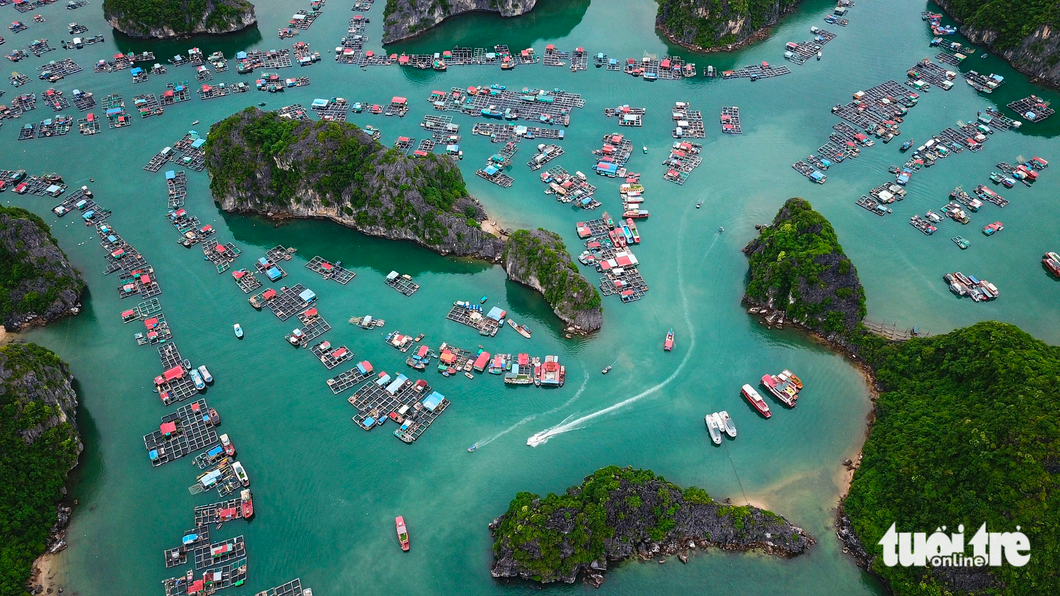Ha Long Bay-Cat Ba Archipelago, located in northern Vietnam, on September 16 was recognized as a new world heritage site by UNESCO, making it Vietnam’s first inter-provincial UNESCO-listed world heritage.
Ha Long Bay in Quang Ninh Province had earned the prestigious World Heritage status twice, first in 1994 and again in 2000.
Cat Ba in Hai Phong, a prominent port city in northern Vietnam, is the country’s largest limestone archipelago.
UNESCO's recognition of the Ha Long Bay-Cat Ba Archipelago as a world natural heritage site is a result of its exceptional natural beauty and the dedicated conservation efforts by the government and local communities.
|
|
| An aerial photo captures Lan Ha Bay in Cat Ba Archipelago in Hai Phong City, northern Vietnam. Photo: Nam Tran / Tuoi Tre |
Authorities in Hai Phong and Quang Ninh have been committed to continuing their close cooperation in environmental management and sustainable tourism development to protect and promote the new world heritage.
The Ha Long Bay-Cat Ba Archipelago boasts a spectacular landscape featuring lush vegetation-clad limestone islands, towering limestone peaks rising above the sea, and stunning karst formations.
In total, the area features a total of 1,133 limestone islands, including 775 in Ha Long Bay and 358 in Cat Ba, most of which are blanketed in lush vegetation.
The waters of Ha Long - Cat Ba include a range of terrigenous and carbonate sedimentary formations spanning in age from the Paleozoic to Neoproterozoic.
These formations often contain paleontological traces in the form of fossils, including species of flora and fauna that are extinct or nearly extinct.
The presence of primeval forests and islands in the bay serves as unique evidence of the continuous movement and development of the area’s karst formations.
With mountains, forests, and islands, the Ha Long Bay-Cat Ba Archipelago is home to a high level of biodiversity, with seven ecosystems including primary tropical rainforests; caves; mangrove forests; intertidal areas; coral reefs; soft bottom areas; and saline lakes.
|
|
| A road stretches through the primeval forest in Cat Ba National Park, Hai Phong City, northern Vietnam. Photo: Nam Tran / Tuoi Tre |
In particular, the Ha Long Bay - Cat Ba Archipelago is also home to many rare species of plants and animals.
It has the largest maritime forest in Vietnam, at more than 17,000 hectares in area.
About 4,910 species of plants and animals inhabit the maritime forest area, 198 of which are on The International Union for Conservation of Nature Red List of Threatened Species and 51 are endemic.
The current primeval forest area of about 1,045.2 hectares on Cat Ba Island, the largest in the namesake archipelago, is one of the important factors creating the ecological value and biodiversity of the heritage.
The Cat Ba langur (Trachypithecus poliocephalus) is on the list of animals at the highest risk of extinction and is recorded in the world red book.
|
|
| The Cat Ba langur (Trachypithecus poliocephalus) is on the list of animals at the highest risk of extinction and is recorded in the world red book. Photo: Nam Tran / Tuoi Tre |
To date, about 60-70 langur individuals have been detected throughout Cat Ba. It is the only place in the world where the species appears.
In addition, there are many endemic plant species in the area which are only adapted to living on limestone islands and cannot be found anywhere else in the world, including Cycas tropophylla, Chirita drakei, Livistona halongensis, and Paphiopedilum concolor, to name a few.
On top of a mountain of Cat Ba National Park is a unique and rare type of submerged vegetation which is usually only grown and distributed in the Mekong Delta of southern Vietnam.
|
|
| Tourists drive around Cat Ba Island, Hai Phong City, northern Vietnam. Photo: Nam Tran / Tuoi Tre |
Like us on Facebook or follow us on Twitter to get the latest news about Vietnam!
















































